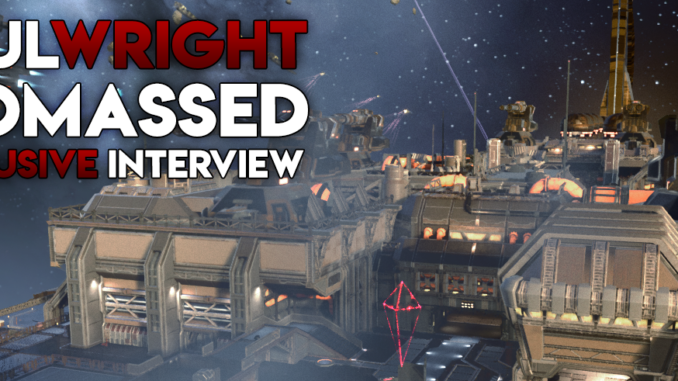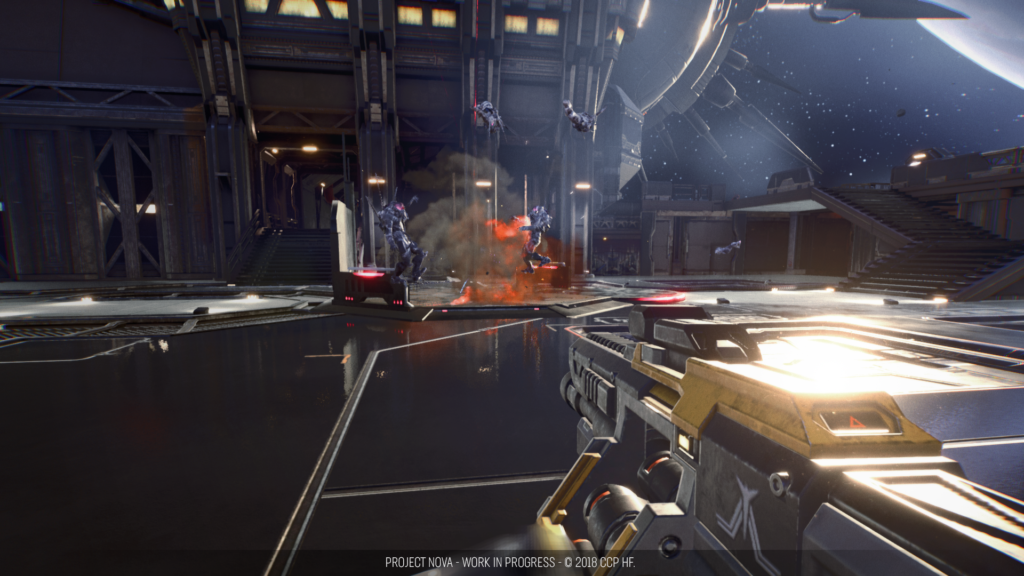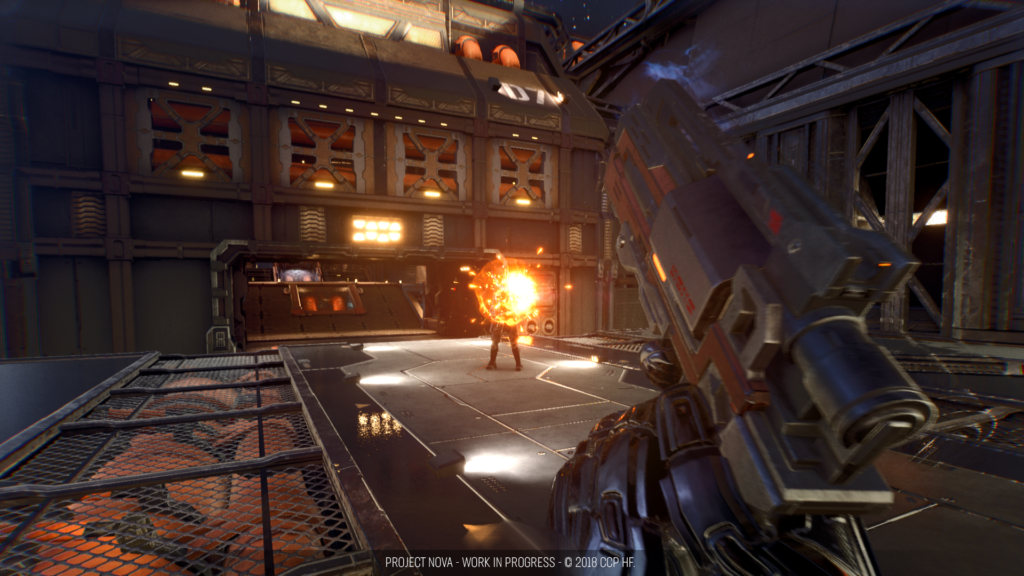
Biomassed had the pleasure of attending EVE Vegas this year, an annual convention put on by CCP Games, the developers of EVE Online. One of CCP’s long-anticipated projects Project Nova, the spiritual successor to DUST 514, the since shut down FPS game set in the EVE Online universe. The game is currently in a pre-alpha state and is being co-developed by CCP Games and Sumo Digital, a UK based independent game developer.
We had a chance to sit down with the Paul Wright, Lead Designer for Project Nova over at Sumo Digital to get his perspective on the development of the game so far. Paul brings over 20 years of experience to Sumo and works as the lead designer for Project Nova, specifically managing the various design teams, monitoring quality, and coordinating with other departments working on the project.
Bringing Strengths Together
With CCP being based out of Iceland and Sumo out of the UK, working on a game with a company in a different country comes with its challenges. Luckily aside from “the obvious challenges of working and communicating with someone who isn’t in the same room as you” the team has not faced any serious challenges. “CCP are incredibly generous [and a] laid-back studio,” he says, “they have similar years of experience as Sumo Digital, been around 15 years, and we’ve both made games before and know how to work with each other.”
Sumo Digital is by no means known for first-person games and has primarily worked on racing and adventure games in the past. However while the studio itself hasn’t produced any FPS games, the individual members of the team bring years of FPS experience to the studio have worked on major titles such as 007: Goldeneye, Timesplitters, Call of Duty, and Crysis, along with lesser known titles such as Commando Strike Force. He continued on to talk about how the size of the team specifically working on Project Nova has gone up and down throughout different stages of production, but stated that on average the number of Sumo employees working on the project have been in “the 20’s to 30’s” which is a sizable chunk of the studio’s 100 or so employees.
While CCP developed DUST 514 entirely in-house, Project Nova’s development is being shared between CCP and Sumo. When asked about what parts of the game’s development is being worked on by Sumo, he explained that it is “purely the first person experience,” and that they are not involved with anything happening outside the battles. This makes sense as the first person experience of DUST was one of the roughest elements of the game and a far cry from the much smoother experience showcased in the Project Nova demo.
Order within the Chaos
While the PvP game mode was not available to play at the event, we had plenty of hands-on experience with Project Nova’s PvE game mode and wanted to learn more about how Sumo had crafted the experience.
Replayability is an important factor for any long-term PvE experience and variability is critical in order to keep the experience from getting stale. While this is a tall task for any game developer, Sumo’s AI engine involves two specific AI managers and constantly gathering information about the current battle state. The Strategy Manager and the Wave Manager are constantly looking at the battle state information and selecting from a “hierarchy of rules” which it issues to the AI. This means that the managers never give the AI specific instructions such as “land here and do this” but rather a general framework of rules that the AI works within.
Because direct commands are never given, and due to the fact that battle state is constantly being updated and in effect the rules that the managers select are always changing, the game experience will never be the same from match to match. Players will need to constantly adapt to the AI that will also be adapting to the players and current battle state which should keep each experience feeling unique. However since the AI is still working within a “probability structure,” players can develop tactics for. “You don’t know how many enemies are going to land or where they’re going to land, but you can guesstimate the difficulty and kind of the rough direction” they’re going to be coming from and plan accordingly.
The advantage of this model is that the AI is adaptive to a wide range of situations and maps which allows the development of new content to mesh much more easily with the AI system which is critical to keep the PvE experiences fresh and engaging. The developers have actually gone through several iterations of this system and are happy with their progress but know that the engine still needs some more work but are confident they’ll get there soon.
No Bullet Sponges
While only the easiest difficulty was available at the playable demo for the sake of players unfamiliar with the game, it was clear that higher difficulty modes are planned. While stating that the method of increasing difficulty is not finalized, he did share some of the methods they’re currently experimenting with to make the game more challenging.
The two managers work in tandem to change a multitude of different variables that can create situations that are more challenging for the player. For example, the Wave Manager can control things like the number of enemies per spawn or where they spawn. It can also cause waves of enemies to have combinations of enemy types that can be more or less difficult to deal when spawned as a group. The Strategy Manager controls the behavior of the units themselves and can issue general rules such as telling the AI to always ignore decoys or to never switch targets during a firefight.
He continued on to talk about how there are so many variables to play with. For example, there can be two different situations where the exact same number and composition of enemies can spawn, but in one situation they spawn in the four corners of the map and in the other they spawn all in the space area. This one variable can lead to drastically different levels of difficulty and they’re focusing on using these variables before they even touch direct enemy attributes such as enemy HP.
It was a relief to hear that the team was shying away from the method of simply increasing enemy HP and damage output to raise the difficulty of the game mode. This often leads to a less than satisfying experience where on the highest levels players are killed overly quickly and enemies turn into bullet sponges, soaking up exorbitant amounts of damage.
The team wants the player to feel like their weapons and suits perform in a consistent and reliable manner regardless of difficulty. He stated that if it takes 5 bullets to kill a particular enemy on easy mode, it should still only take 5 bullets to kill that enemy on hard mode. This way the player can make meaningful plans and develop tactics ahead of time rather than feeling like they’re getting weaker as the difficulty increases.
The Path Forward
Paul was unfortunately unable to comment on much specifics regarding specific upcoming features but was enthusiastic about the reaction of the players trying the demo out. He is very proud of the team and happy that everything has come together in the way it has and is looking forward to continuing to work on the project.
The Biomassed team would like to thank Paul for his time and look forward to seeing more of Project Nova in the Alpha starting this November.


